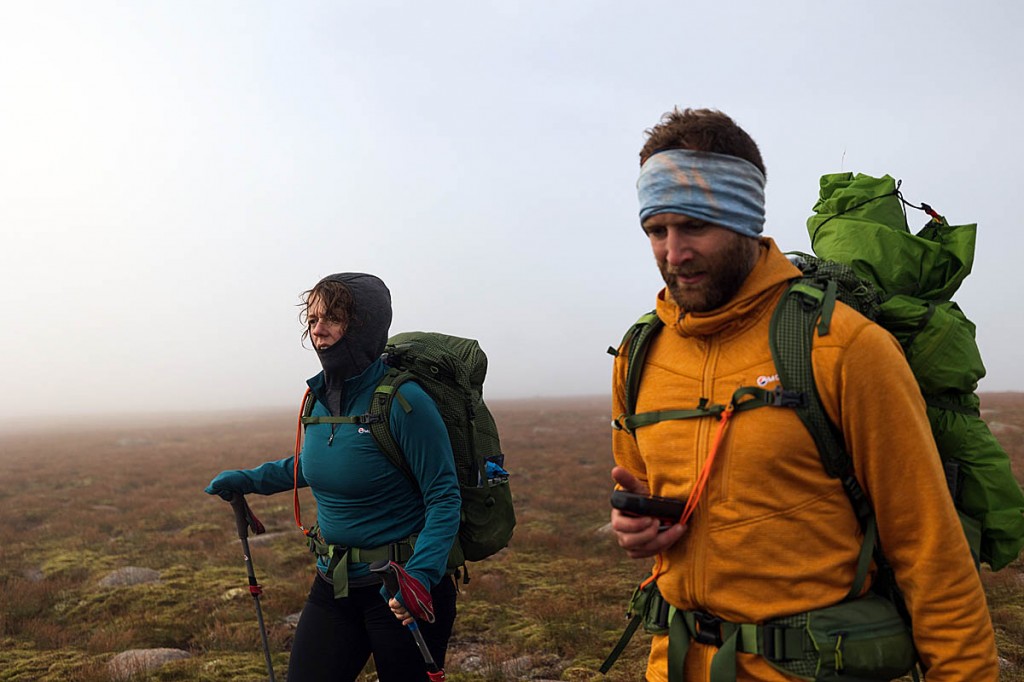
Jenny Graham and Calum Maclean are believed to be the first walkers to complete the route. Photo: Johny Cook
An expert’s answer to a geographical social media query prompted what turned out to be a gruelling Highland expedition for a pair of adventurers.
Jenny Graham and Calum Maclean have completed what is thought to be the first traverse of the ‘longest straight line in Britain’.
The route, across the Cairngorms national park, was calculated by Ordnance Survey to be the longest line across British terrain that doesn’t cross a metalled road.
The pair used the information to follow a wild 80km route from the A9 to the A939, hiking, scrambling and wading across the heart of the national park.
They followed a bearing of 67 degrees – roughly east-northeast – for four days, wild camping each night wherever they stopped. The Highland terrain, with no paths or trails, included steep hills, mountain summits, forests, crags, gullies, river crossings, countless streams, a waterfall, bogs, peat hags and many miles of thick heather.
The pair finished the 78.55km journey, with a total ascent of 5,706m, on Monday evening.
The route of the longest linear walk in Britain without crossing a road was first determined in 2018 by the government mapping agency after a question posed on Twitter, asking what and where is the longest distance you can walk in a straight line in England/Wales/Scotland without crossing a road – defined as a paved surface for vehicular use.
OS experts set about searching for a route and decided the longest straight line between asphalt roads was from the A9, just north of the Drumochter Pass, to the A939, south of Corgarff.
They concluded the exact straight-line distance was 71.5km (44.43 miles) with a total ascent of about 5,394m (17,700ft). The highest point is the summit of Beinn a’Bhuird at 1,197m (3,927ft), the 11th highest mountain in the UK.
Other mountains on the route include Beinn Bhrotain and Ben Avon. At the time of plotting the line, an OS expert said: “I wouldn’t recommend anyone do it unless they are very conversant with a map and compass.
“It is not following known tracks or paths and it looks like there may well be several scrambles along the way, too.”
Calum Maclean, a broadcaster and presenter, said: “Walking in a straight line did feel very unnatural. I had a mix of feelings, from monotonous and depressing to really joyful.
“Overall, it was quite gruelling. But then, when we reached the summits and got the opportunity to gaze back from where we’d come, it was a real feeling of satisfaction.
“We could draw a line with our eyes, which linked the heather below our feet to the river in the glen below, the deep hidden gullies, rocks on far-off hills and beyond into the distance.
“In those moments, I think the purpose of walking a straight line became a bit clearer.”
Jenny Graham, a round-the-world record-breaking cyclist, said: “Walking in a straight line sounds like the simplest of all adventures but it turned out to be the most complex navigation of any trip I’ve been on.
“However, completing the route and sticking as close to the line as possible while exploring the national park in such a unique fashion was pretty special.”
Maclean, 32, of Aberfeldy, Perthshire, and Graham, 42, of Inverness, are thought to be the first to complete an end-to-end journey of Britain’s longest linear walk without encountering a road.
There are reports of a couple of previous attempts but each was aborted. The pair set out on Friday at 9.16am and finished at 9.12pm on Monday, taking a total of 83hrs 56mins.
The walkers reported that it was much harder than they imagined keeping a straight line on unpredictable terrain. Graham said: “It’s really tricky to stop yourself veering from the bearing on rough ground. You think you know what a straight line is but then you look at the GPS and realise you don’t.
“You also have to let go of everything that is in your head. Sometimes this means not doing what appear to be the most sensible when looking at the terrain.”
Maclean added: “We tried following a compass bearing but it wasn’t that accurate. Then we followed a line on our GPS devices, which was better but still difficult.
“Even a small gully is hard when you have to go in a straight line. Commonsense says go round it, but we were determined to stick to the straight line.”
The pair were also surprised by how slow their progress was. Graham said: “We walked in a straight line for 11 hours and we covered just 10 miles on day one. They were the toughest 10 miles of my life.
“On day two, it took us 13 hours to do 13 miles. That’s a mile an hour. It was so tough on all the heather and with so many steep ups and downs.”
Maclean revealed that when walking through peat hags on the first day they were reduced to a speed of ‘just 3km per hour. That is so slow’!
Many miles of deep heather-covered hills, mountains and moorland made the going arduous. Graham said: “At some points I was crawling up heather on my hands and knees.”
Maclean added: “I was cursing every bit of heather on day two. But also the terrain was incredibly monotonous at times. It was a real slog.”
By the end of day three, the friends had journeyed 61 hours in a straight line.
Graham said: “We sleep, eat, cross everything in our paths in one straight line. It is very hard but also amazing.”
Maclean said: “We knew there would be many crags on the straight line and we were worried about what we would come across. There were huge slabs on some descents and they were wet with water running over them.
“A few times we attempted to down climb but it was too risky and so we had to slightly detour off the line. This only happened a few times though, thankfully.”
Another tough section came at the end of the longest straight line on day four. Calum Mclean said: “The line just stopped but we weren’t at a road. It stopped at a track.
“We looked at the map and we had to make it through a thick forest to get to the A939. This was one of the toughest parts of the entire line.
“We actually did a few kilometres more than OS had suggested for the route because we needed to make it to the road.”
On day one, the keen wild swimmer was delighted by the discovery of a hidden waterfall. He said: “We found a stunning series of waterfall pools tumbling through a gorge, which resembled a series of steps.
“It was a place I might never have visited if it weren’t for walking the line – and they’re now bookmarked for a return to swim, as they were about 100m off the line, which was too far for us.”
As they came to the mountain pass of the Lairig Ghru on day three, the walkers were treated to ‘amazing views’.
Maclean said: “There was a temperature inversion and the view was amazing. It was very uplifting.”
They also enjoyed days of sunshine and ‘the best blaeberries; so sweet and juicy’.
As the days passed, the pair became more familiar with their challenge. Graham said: “I am not used to walking with a backpack – they weighed about 16kgs – and at first it was hard. I was really worried about my sore ankles the first night. But then I think my body adapted.
“It was such a cool experience, doing something that others had not and reaching places I had never visited despite thinking that I knew the Cairngorms so well.”
The pair were supported by outdoor gear brand Exped and clothing company Montane.
Chris Gordon, of Exped UK, said: “What seems on paper to be such a simple idea, following a constant straight line, when taken to an environment like the Cairngorms and followed as exactly as Jenny and Calum have across mountain tops, rivers and crags makes for a truly inspiring adventure and a remarkable achievement.
“In addition, the expedition proves, if it was ever in doubt, that we can find truly wild and exciting journeys on our own small island.”
Ordnance Survey has calculated that in Wales the longest straight walk without encountering a road is 22.2km and runs along the south of the Cambrian Mountains.
For England, the longest straight walk is in the North Pennines and is 29.8km.
Film production company Summit Fever Media intend to premiere a 20-minute film of the longest line project at Kendal Mountain Festival 2021 in November.
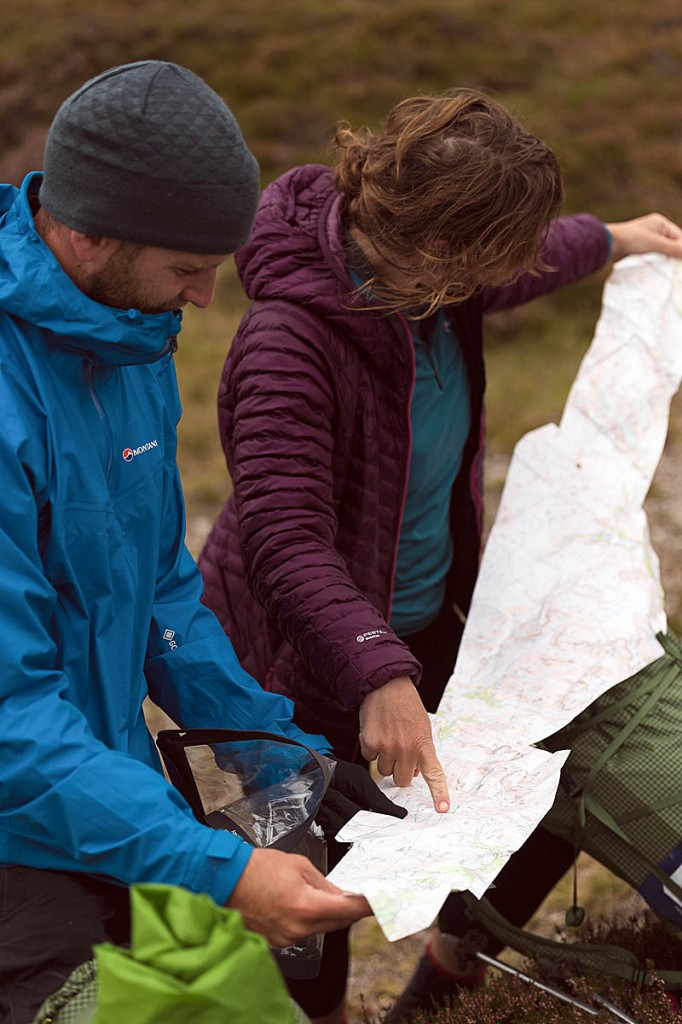
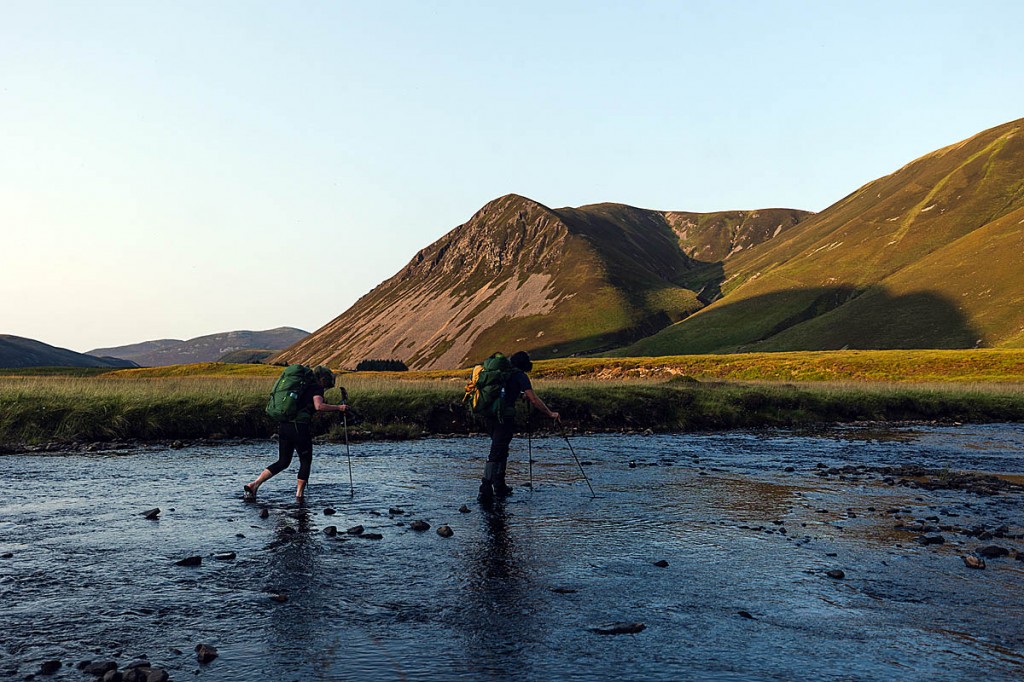
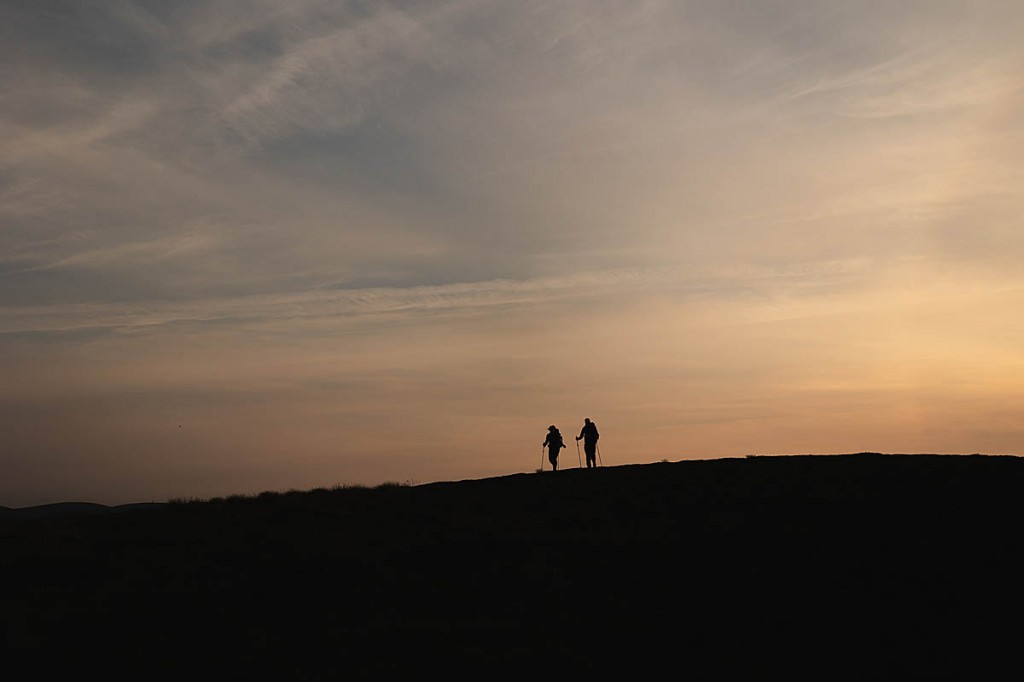
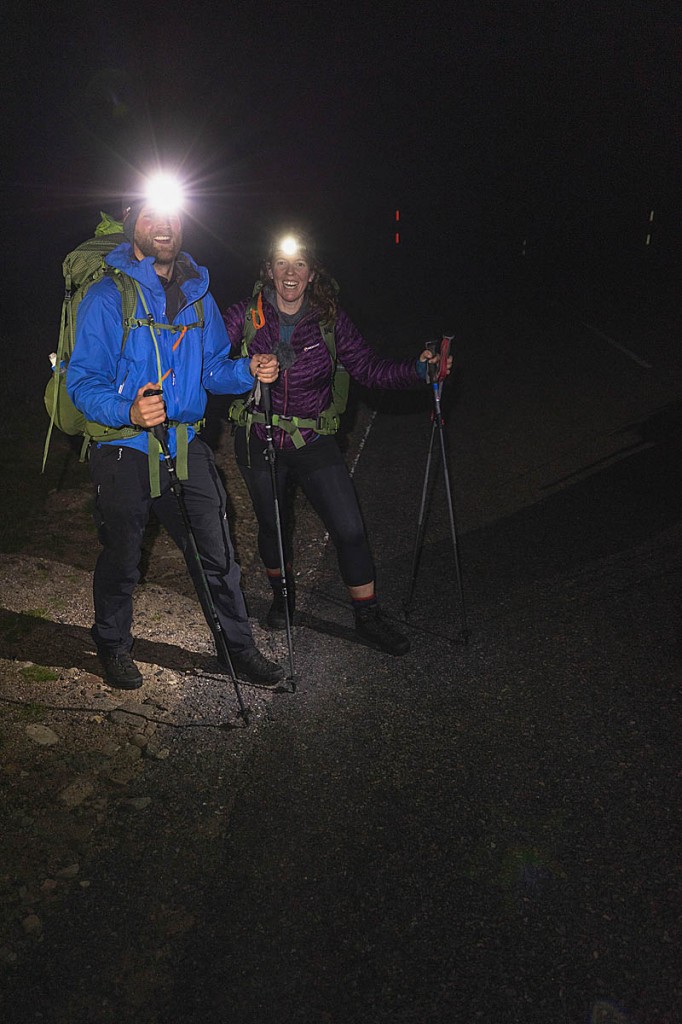
Kevin de Silva
31 August 2021Not sure that's a first as I know at least 5 people including my self who did it in the late 70's in fact we did all three . Back when people (mostly scouts) did these things for fun
Jock
01 September 2021What definition of "straight" was used? Considering that the earth is far from flat that's mathematically a tricky one. Perhaps some tunneling was in order to avoid the ups and downs!
James
01 September 2021Kevin - the personalities with their 'new ideas' never seem to have much grasp of mountaineering history.
Nicholas Willis
01 September 2021Talk about grasping at straws to get their 5 minutes of fame. How sad.
Colin
02 September 2021Great point Jock!
"Using OS MasterMap Highways road network, our CaTS team calculated the areas of all the polygons to identify the largest ones. This included all roads that are navigable by car, so the start and end points of the ‘straight walk’ start on vertices that are inherently within the OS MasterMap Highways road network. They then had to identify the longest straight line of sight that could be made between opposing vertex points that did not cross a road."
https://www.ordnancesurvey.co.uk/newsroom/blog/gbs-longest-linear-walk-without-crossing-a-road
Go read the warnings about the English and Welsh lines!
Peter Richards
02 September 2021So we're all agreed they've wasted their time with all that attention seeking because they haven't actually done what they claim.